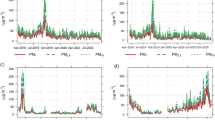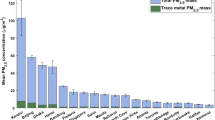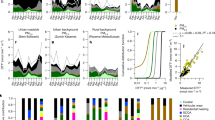Abstract
People who live in Appalachian areas where coal mining is prominent have increased health problems compared with people in non-mining areas of Appalachia. Coal mines and related mining activities result in the production of atmospheric particulate matter (PM) that is associated with human health effects. There is a gap in research regarding particle size concentration and distribution to determine respiratory dose around coal mining and non-mining areas. Mass- and number-based size distributions were determined with an Aerodynamic Particle Size and Scanning Mobility Particle Sizer to calculate lung deposition around mining and non-mining areas of West Virginia. Particle number concentrations and deposited lung dose were significantly greater around mining areas compared with non-mining areas, demonstrating elevated risks to humans. The greater dose was correlated with elevated disease rates in the West Virginia mining areas. Number concentrations in the mining areas were comparable to a previously documented urban area where number concentration was associated with respiratory and cardiovascular disease.
This is a preview of subscription content, access via your institution
Access options
Subscribe to this journal
Receive 6 print issues and online access
$259.00 per year
only $43.17 per issue
Buy this article
- Purchase on Springer Link
- Instant access to full article PDF
Prices may be subject to local taxes which are calculated during checkout



Similar content being viewed by others
References
Hinds WC . Aerosol Technology: Properties, Behavior, and Measurement of Airborne Particles. John Wiley & Sons: New York, NY. 1999.
Dockery DW . Epidemiologic evidence of cardiovascular effects of particulate airpollution. Environ Health Perspect 2001; 109: 483–486.
Dominici F, Peng RD, Bell ML, Pham L, McDermott A, Zeger SL et al. Fine particulate air pollution and hospital admission for cardiovascular and respiratory diseases. JAMA 2006; 295: 1127–1134.
Pope CA, Burnett RT, Thun MJ, Calle EE, Krewski D, Ito K et al. Lung cancer, cardiopulmonary mortality, and long-term exposure to fine particulate air pollution. JAMA 2002; 287: 1132–1141.
US EPA Particulate Matter (PM). US EPA Air & Radiation 2013. Retrieved from www.epa.gov/pm/index.html.
Donaldson K, Stone V, Clouter A, Renwick L, MacNee W . Ultrafine particles. Occup Environ Med 2001; 58: 211–216.
Kim CS, Jaques PA . Analysis of total respiratory deposition of inhaled ultrafine particles in adult subjects at various breathing patterns. Aerosol Sci Technol 2004; 38: 525–540.
Oberdorster GE, Oberdorster E, Oberdorster J . Nanotoxicology: an emerging discipline evolving from studies of ultrafine particles. Enviorn Health Perspect 2005; 113: 823–839.
Sioutas C, Delfino RJ, Singh M . Exposure assessment for atmospheric ultrafine particles (UFPs) and implications in epidemiologic research. Environ Health Perspect 2005; 113: 947–955.
Lippmann M, Yeates D, Albert R . Deposition, retention, and clearance of inhaled particles. Br J Ind Med 1980; 37: 337–362.
Anderson ZJ, Wahlin P, Raaschou-Nielsen O, Ketzel M, Scheike T, Loft S . Size distribution and total number concentration of ultrafine and accumulation mode particles and hospital admissinos in children and the elderly in Copenhagen, Denmark. Occup Enviorn Med 2008; 65: 458–466.
Hogg JC, van Eeden S . Pulmonary and systemic response to atmospheric pollution. Respirology 2009; 14: 336–346.
US EPA What is Mountaintop Mining? Mid-Atlantic Mountaintop Mining 2013. Retrieved from http://www.epa.gov/Region3/mtntop/.
Hendryx M . Mortality from heart, respiratory, and kidney disease in coal mining areas of Appalachia. Int Arch Occup Enviorn Health 2009; 82: 243–249.
Hendryx M, Ahern MM . Relations between health indicators and residential proximity to coal mining in West Virginia. Am J Public Health 2008; 98: 669–671.
Hendryx M, Zullig KJ . Higher coronary heart disease and heart attack morbidity in Appalachian coal mining regions. Prev Med 2009; 49: 355–359.
Hendryx M . Poverty and mortality disparities in central Appalachia:mountaintop mining and environmental justice. J Health Disparities Res Pract 2011; 4: 44–53.
Ahern MM, Hendryx M, Conley J, Fedorko E, Ducatman A, Zullig KJ . The association between mountaintop mining and birth defects among live births in central Appalachia, 1996–2003. Environ Res 2011; 111: 838–846.
Esch L, Hendryx M . Chronic cardiovascular disease mortality in mountaintop mining areas of central Appalachian states. J Rural Health 2011; 27: 350–357.
Esch LM, Lusk S, Hendryx M, McCawley M Comparison of particle size distribution and concentration between MTR and non-MTR areas in West Virginia. Prepared for the American Association for Aerosol Research 30th Annual Conference, Orlando, October 2011.
Hendryx M, Wolfe L, Luo J, Webb B . Self-reported cancer rates in two rural areas of West Virginia with and without mountaintop coal mining. J Commun Health 2011; 37: 320–327.
University of Wisconsin Population Health Institute West Virginia Rankings. County Health Rankings and Roadmaps 2012 Retrieved from www.countyhealthrankings.org/#app/west-virginia/2012.
West Virginia Office of Miners’ Health Safety and Training 2011 Calendar Year Statistical Report. West Virginia Office of Miners’ Health Safety and Training 2012. Retrieved from www.wvminesafety.org/2011statisticalreport.htm.
United States Census Bureau. State & County QuickFacts. 2011. Retrieved from. http://factfinder2.census.gov/faces/nav/jsf/pages/index.x.html.
WV Division of Tourism Research . Quick County Facts:Pocahontas County. WV Department of Tourism 2006 Retrieved from www.pocahontascountywv.com/files/quick_county_facts.pdf.
Division of Air Quality Air Monitoring. West Virginia Department of Enviornmental Protection 2011. Retrieved from http://www.dep.wv.gov/daq/air-monitoring/Pages/dataprocessing.aspx.
Stahlhofen W, Rudolf G, James AC . Intercomparison of experimental regional aerosol deposition. J Aerosol Med 1989; 2: 285–308.
National Weather Service Forecast Office Climate Data. National Oceanic and Atmospheric Administration 2009 Retrieved from http://www.nws.noaa.gov/climate/local_data.php?wfo=rlx.
Levy JI, Spengler JD . Modeling the benefits of power plant emissions controls in Massachusetts. J Air Waste Manage Assoc 2002; 52: 5–18.
MacIntosh DL, Levy JI, Spengler JD Testimony before the Wisconsin Public Service Commission: Matter of a Pollution Control Construction Permit, Case No. IH-04-03 2003.
Wilson WE, Suh HH . Fine and coarse particles:concentration relationships relevant to epidemiological studies. J Air Waste Manage Assoc 1997; 47: 1238–1249.
Kolker A, Egle M, Orem W, Tatu C, Hendryx M, McCawley M et alAtmospheric particulate matter in proximitiy to mountaintop coal mines. Prepared for the VM Goldschmidt Conference, Montreal, June 2012.
Knuckles T, Stapleton PA, Minarchick VC, Esch L, McCawley M, Hendryx M et al. Air pollution particulate matter collected from an Appalachian mountaintop mining site induces microvascular dysfunction. Microcirculation 2013; 20: 158–169.
Ghose MK, Majee SR . Characteristics of hazardous airborne dust around an Indian surface coal mining area. Environ Monit Assess 2007; 130: 17–25.
Acknowledgements
We acknowledge Bean Chen (National Institute of Occupational Safety and Health, Morgantown, WV, USA) Matthew Gurka (School of Public Health, West Virginia University), and Timothy Nurkiewicz (School of Medicine, West Virginia University) for their assistance and support.
Author information
Authors and Affiliations
Corresponding author
Ethics declarations
Competing interests
The authors declare no conflict of interest.
Rights and permissions
About this article
Cite this article
Kurth, L., McCawley, M., Hendryx, M. et al. Atmospheric particulate matter size distribution and concentration in West Virginia coal mining and non-mining areas. J Expo Sci Environ Epidemiol 24, 405–411 (2014). https://doi.org/10.1038/jes.2014.2
Received:
Accepted:
Published:
Issue Date:
DOI: https://doi.org/10.1038/jes.2014.2
Keywords
This article is cited by
-
Adult asthma associated with roadway density and housing in rural Appalachia: the Mountain Air Project (MAP)
Environmental Health (2023)
-
Analyses of oxidative DNA damage among coal vendors via single cell gel electrophoresis and quantification of 8-hydroxy-2’-deoxyguanosine
Molecular and Cellular Biochemistry (2023)
-
Coal dust exposure induces proliferation and migration of human bronchial epithelial cells
Molecular & Cellular Toxicology (2023)
-
Study on respiratory deposition doses of typical Indian opencast coal mineworkers using occupational particulate matter levels
Air Quality, Atmosphere & Health (2021)
-
Variation in concentrations of particulate matter with various sizes in different weather conditions in mining zone
International Journal of Environmental Science and Technology (2020)



